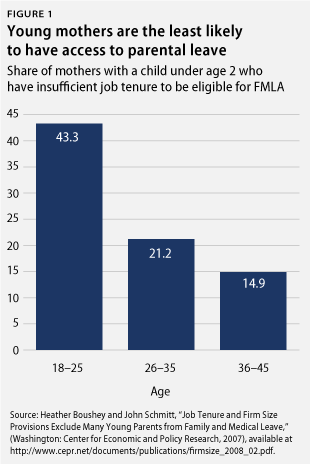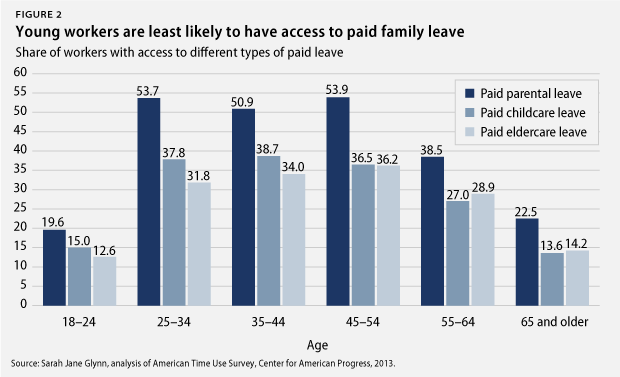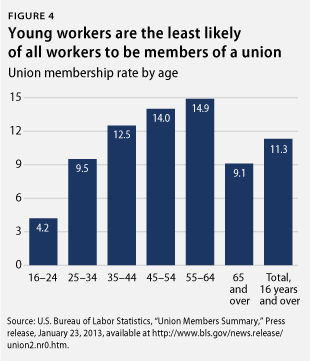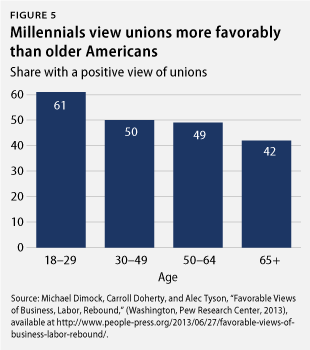Introduction
Millions of young Americans are struggling to find work, and even those who have a job have no guarantee of economic security. To the contrary, Millennials are disproportionately stuck in low-quality jobs that lack sufficient pay and adequate workplace protections. With a 14 percent unemployment rate among Americans under age 25, job creation is necessary to generate economic opportunities for Millennials. But an economy that works for young Americans also requires high-quality jobs that ensure a middle-class standard of living.
Americans of all ages will benefit from better wages and enhanced worker protections, but Millennials have the most to gain from improving the quality of American jobs. This is because young Americans in their 20s are the people who most need good jobs that can support a family, yet they are also the least likely to have them. Half of American women have their first child by the age of 25, which means that Millennials need well-paying, secure jobs that will allow them to raise America’s next generation. Young workers, however, are the group most likely to earn the federal minimum wage of $7.25 per hour or less, a wage that is not sufficient to keep a small family above the poverty line. Young workers are also the least likely to have access to family leave and paid sick days, which means many must risk their jobs to care for themselves or a sick family member. Millennials know that unions improve wages and benefits for workers; unfortunately, a union election process that is stacked against workers stymies those who try to form a union. And because federal law does not prevent employment discrimination against lesbian, gay, bisexual, and transgender, or LGBT, workers, young LGBT Americans face job insecurity and economic instability.
In this brief, we outline four policies that Congress should enact to ensure that young Americans have good, middle-class jobs that can support a family. These are smart policies that will strengthen the middle class and enhance job security for all workers, but they will especially benefit Millennials. Lawmakers can improve Millennials’ economic security by raising the minimum wage, guaranteeing paid family and medical leave, enacting comprehensive labor-law reform, and banning employment discrimination against LGBT workers.
Raise the minimum wage
Today, the minimum wage is insufficient. A full-time, minimum-wage worker earns just $14,500 a year—$5,000 less than the official poverty line for a family of three and $8,000 below the poverty line for a family of four. That said, the official poverty threshold is widely regarded as an extremely low bar. This is why many federal anti-poverty programs set their guidelines much higher. The Supplemental Nutrition Assistance Program, or SNAP, for example, sets the eligibility threshold at 130 percent of the federal poverty line. When polled, Americans said that a family of four needs to earn an average of $52,000 yearly to get by. By that measure, even two parents working full time at the minimum wage would not be able to support a family. According to an analysis by the National Low Income Housing Coalition, a single mother of two earning the minimum wage could not afford rent in any state in the country.
Raising the minimum wage would benefit workers of all ages, but it would especially benefit Millennials. This is because Millennials are more likely than older workers to work at a job that lacks sufficient minimum pay. Workers under age 25 constitute only about one-fifth of hourly paid workers, but they make up about half of those paid the federal minimum wage or less. Today’s young people are more likely to make the federal minimum wage than young workers in the past. Over the past decade, the share of hourly paid workers under the age of 25 who were paid the minimum wage grew from 7 percent to 12 percent.
This might pose less of a problem if the minimum wage only affected teenagers earning extra spending money, but most of the workers who would benefit from increasing the minimum wage are adults who depend on their earnings to support a family. According to an analysis by the Economic Policy Institute, 88 percent of the workers who would benefit from raising the minimum wage to $10.10 an hour are at least 20 years old. The affected workers earn about half of their family’s total income on average, and 44 percent have at least some college education.
Congress should raise the minimum wage to $10.10 and index it to inflation or—better yet—to the growth in average wages. This would enable the 1.8 million workers under the age of 25 who are currently earning the minimum wage or less to stay out of poverty and provide a better quality of life for their families. What’s more, raising the minimum wage also leads to a “spillover effect,” meaning that workers earning slightly more than the minimum wage will see a wage increase as firms seek to preserve the company’s wage structure.
Increasing the compensation of low-wage workers has also been shown to reduce employee turnover, boost worker productivity, encourage employers to invest in training for their workers, and increase the demand for goods and services. For these reasons, economists increasingly agree that raising the minimum wage does not kill jobs—even when it is done during hard economic times.
Guarantee paid family and medical leave
American workers do not have universal access to time off from work, which means many Americans are forced to choose between their jobs and caring for themselves or a family member in need. Guaranteed paid family and medical leave would especially benefit young workers, who disproportionately lack access to these protections.
Lack of access to paid family and sick leave reduces Americans’ economic opportunities and creates substantial financial and health-related costs for all of us. Workers who lack access to family leave are more likely to drop out of the labor force. Among mothers who have paid leave, about 9 in 10 return to work within a year of giving birth. In contrast, among new mothers who quit their jobs, less than half returned to work within a year. Without paid sick days, many workers must risk their jobs to care for themselves and their families. Twenty-three percent of adults say they have been threatened with termination or fired for taking time off when they or a family member were sick.
Failing to provide workers adequate access to leave also creates significant social and economic costs. Consider that women who take paid leave and return to work are 39 percent less likely to receive public assistance and 40 percent less likely to receive food stamps in the year following a child’s birth than women who return to work without taking leave. This might be because women who cannot take leave are more likely to have unexcused absences, causing them to lose out on promotions and higher wages. Workers with access to paid sick days are more likely to use preventive health services such as cancer screenings and tests, and they are less likely to use costly hospital emergency rooms. In fact, researchers estimate that universal paid sick leave would reduce emergency room visits by 1.3 million each year, saving $1.1 billion in medical costs annually. Workers with access to paid sick days are also nearly one-third less likely to be injured on the job, resulting in lower health care and employer costs.
Finally, workers without paid sick leave are 1.5 times more likely to go to work sick and contagious than those who have paid sick days. Close to 90 percent of employees in food service—an industry with a high share of young workers—do not have paid sick days, leading more than two-thirds of restaurant employees to report that they have cooked, prepared, or served food while sick.
Expanding access to paid family leave and sick days would improve financial security and labor-force connections for workers of all ages, but young workers would benefit the most. This is because Millennials are the least likely of all workers to have access to time off to care for themselves and their families, even though millions are parents and caregivers. About half of American women have their first child before the age of 25, but young parents are the least likely to be eligible for the Family and Medical Leave Act of 1993, or FMLA, or to have access to paid leave. Moreover, about 14.5 million people under age 35 serve as unpaid family caregivers, often to an ailing parent or grandparent. Yet the majority of young workers do not have access to paid elder care leave.
The FMLA was a critical first step to help workers manage their commitments to both work and family, but it is not helping the young people who need it most. The FMLA provides employees with 12 unpaid weeks of job-protected leave for the birth or adoption of a child; the foster care of a child; the care of a seriously ill child, spouse, or parent; or an employee’s own serious illness. But workers are only eligible for FMLA if they have at least 12 months of tenure with their employer, have worked at least 1,250 hours, and work for an employer who employs at least 50 people within a 75-mile radius of the employees’ work site. The job-tenure requirement alone renders many young parents ineligible for FMLA; among workers ages 18 to 25, 43.3 percent of women and 31.2 percent of men with a child at home have held their job for less than a year. Among young African American parents, nearly half are ineligible for FMLA due to job-tenure requirements.

Even when workers are eligible for unpaid leave under the FMLA, they often cannot afford to take it. Nearly 90 percent of eligible workers who needed leave said that they would have taken it if they had received some pay. Moreover, FMLA does not apply to same-sex partners who live in states that do not have marriage equality, and it does not allow time off to care for a grandparent. Unfortunately for young workers, employers are not picking up the slack in federal law by offering their employees more generous leave policies. Young workers are much less likely than older workers to have access to any kind of paid family leave at their job.

Young workers are also the least likely to have access to paid sick days. Just 24 percent of workers under age 25 can use paid sick days, compared with more than 60 percent of workers ages 35 to 64.

Congress should enact a national paid family and medical leave program that would provide up to 12 weeks of partial wage replacement to allow workers time to care for a new child, help a seriously ill family member, or recover from one’s own illness. America’s social insurance contract has successfully and effectively provided income insurance for workers upon retirement, disability, or death for nearly 80 years, but it does not provide any income replacement for workers who need time off to care for their family members or recover from a serious illness. The Center for American Progress has proposed a plan that would make it possible for Millennials to have children, care for ill family members, or get sick without fearing that they will lose their pay, their opportunity to advance in the workplace, or their jobs.
Congress should also approve the Healthy Families Act, which would allow workers to earn paid sick leave to use when they are sick, to care for a sick family member, to obtain preventive care, or to address the impacts of domestic violence. Access to paid sick days would benefit the many young workers who are currently forced to choose between their job, their health, and the health of their family members.
Reform labor laws so that workers who want to form a union are able to do so
Union membership rates are at record lows, and young workers are the least likely of all workers to belong to a union. Boosting union membership is one of the most important things we can do to increase wages and benefits, reduce inequality, and strengthen the middle class. Union workers earn 11.3 percent more—or $2.72 more per hour in 2013 dollars—than their nonunion counterparts. Researchers at the Center for American Progress Action Fund found that if unionization rates increased by 10 percentage points—to roughly the level they were in 1980—the typical middle-class household, unionized or not, would earn $1,501 more each year. That’s roughly the same effect as boosting college graduation rates by the same margin.
But the union-election process is stacked against workers. Employers, for example, can legally require workers to attend anti-union meetings, and they can subject workers to one-on-one meetings about unionization with their direct supervisors. Companies can also prevent workers from discussing the union except outside of work—but they do not have to provide pro-union workers with complete contact details for their colleagues, including email addresses. Employers who break the law—by harassing, intimidating, or even firing workers—face penalties so low that many anti-union companies view them as nothing more than the cost of doing business. When workers do manage to elect to form a union despite this uneven playing field, many corporations then use delay tactics to stall the negotiation of a first contract indefinitely. As a result, just one in every seven organizing drives that files a petition for an election reaches a first contract within one year of certification.
Millennials have the most to gain from boosting union membership both because they have the lowest union membership rates and because they are more likely to work in lower paying jobs with fewer benefits. Just 4.2 percent of workers under age 25 were union members in 2012, compared with 11.3 percent of all workers. Among workers ages 25 to 34, 9.5 percent are unionized.

The low union membership rate among young workers is not due to Millennials’ dislike for unions. In fact, according to a recent Pew Research poll, Americans under age 30 view unions much more positively than older generations. In a detailed analysis of Millennials’ views on major social and policy issues, political scientists David Madland and Ruy Teixeira explain that “Millennials tend to view unions as important social institutions that advance progressive causes such as empowering workers, enforcing labor standards, and ensuring workers are awarded their fair share of productivity gains.”

Young workers want unions. The share of workers who want a union has risen substantially since the 1990s, with a majority of nonunion workers now reporting that they want to join a union. Over the past year, thousands of fast-food workers, most of them in their 20s, have staged walkouts at restaurants across America. They are demanding the right to organize a union without retaliation and an increase in the minimum wage.
Promoting good jobs for Millennials requires addressing the flawed labor-law process that impinges on workers’ ability to form a union. Congress should pass comprehensive labor-law reform that establishes a fair process for workers to decide on union representation, expands coverage so more workers are provided the right to organize, establishes meaningful penalties and remedies for workers who are fired or discriminated against for exercising their right to organize, and promotes productive collective bargaining for first contracts so that young workers can negotiate for improved wages and benefits.
Enact the Employment Non-Discrimination Act to prohibit employers from discriminating against LGBT workers
It is legal in America to fire a person for being LGBT. The failure of federal law to protect LGBT workers from employment discrimination means that too many Americans are not hired, not promoted, or even fired from a job due solely to their sexual orientation and gender identity. Enacting workplace protections for LGBT workers is the right thing to do for all Americans, and it would especially benefit Millennials, who are coming out at a younger age than previous generations.
Millennials have grown up in a society that increasingly recognizes the rights of LGBT people. Perhaps as a result of this progress, 9 out of 10 voters mistakenly believe that LGBT workers already have federal protection against employment discrimination. In fact, there is no federal law that protects LGBT workers from workplace discrimination, and most employers have free range to discriminate on the basis of sexual orientation and gender identity.
Many employers do discriminate, as the Center for American Progress explores in its “Workplace Discrimination Series.” Studies show that anywhere from 15 percent to 43 percent of lesbian, gay, and bisexual workers have been discriminated against or harassed in the workplace. Ninety percent of transgender workers have experienced harassment, mistreatment, or discrimination on the job or took action to hide who they are to avoid it. Largely as a result of discrimination, LGBT families report lower annual earnings and higher rates of poverty than non-LGBT families.
Protecting LGBT workers from employment discrimination is especially important to Millennials. Young people today come out to their friends and family at a much earlier age—age 16 on average, down from age 25 in 1991—which increases the odds that young LGBT workers will face discrimination at an earlier age. Today’s high level of youth unemployment also makes it difficult or impossible for LGBT workers to find a better job when they are discriminated against or harassed by their current employer.
Congress should enact the Employment Non-Discrimination Act, or ENDA, which would protect private and public employees from employment discrimination on the basis of perceived or actual sexual orientation and gender identity. This would improve economic security for all Millennials and ensure that LGBT workers do not have to hide who they are just to keep their jobs. On November 7, the Senate passed ENDA with bipartisan support, and it is now up to the House of Representatives to consider and approve this important legislation.
Conclusion
Youth unemployment is not the only thing holding back Millennials in today’s economy. Too many young Americans struggle to make ends meet and support a family even when they have full-time jobs. This is because young workers are the most affected by insufficient wages and a lack of family and medical leave, even though workers in their 20s are the most likely to have young children to support. These problems are compounded by low union membership rates and a flawed labor-law system that hinders workers’ ability to organize. Additionally, young LGBT workers face serious economic challenges without federal protection from workplace discrimination.
Lawmakers must invest in job creation, and we have proposed measures to put young people to work today. But we must also enact policies that ensure Millennials have good, well-paying, middle-class jobs that allow them to raise America’s next generation. This means raising the minimum wage, guaranteeing paid family and medical leave, strengthening workers’ rights to form a union, and prohibiting employers from discriminating against workers on the basis of sexual orientation and gender identity. These measures will create economic opportunities for Millennials today and facilitate America’s economic prosperity in the long term.
Sarah Ayres is a Policy Analyst in the Economic Policy department at the Center for American Progress.